Problems of implementation of innovative projects
Russia's innovative economy: a persistent feeling that "the drive belts are smoking and the flywheel is barely spinning." In this matter, it is important to prevent the slightest dramatization and stop value judgments. To discern progressive trends and prerequisites for system solutions, it is necessary to dive into the subject area of the basic design methodology. Prepare in detail an innovative project as an essential phenomenon, determine the types, methods of selection and initiation, models of execution. This gives a sense of support and the source of knowledge.
Basic points of innovation theory
The concept of innovation in a general sense is the changes made that allow significant innovations in the process of thinking and acting. Business innovation is an invention, an innovation brought to the stage of a commercial or other new product. It can significantly change the balance of power in the market due to obvious advantages over competitors. This definition does not pretend to be a canon due to the fact that the concept itself has not yet taken root in the modern world. The innovative concept follows the idea of invention and innovations in the form of other, previously unused:
- ways;
- funds;
- methods;
- products;
- technologies.
Innovation must have practical application. Alongside the concept of “innovation” there are always accompanying “innovation process”, “innovative projects” and “innovative activity”. The concept of activity was introduced into scientific and business use by Academician L.I. Abalkin. Below are some of the definitions he gave.

The philosophical meaning of creating innovations is to resolve the regularly arising contradictions between existing opportunities and increased needs. The effectiveness of the new in business is to meet the expectations of consumers and lay the foundation for the expanded reproduction of the innovation process. Therefore, the development and market use of innovations should be a priori profitable. Thus, the signs of the introduction of a new one are as follows.
- Novelty as a collection of unique scientific and technical knowledge.
- The ability to be realized in products, technologies that appear on the market or in society for the first time or in a new quality.
- Meeting the expectations of the target audience, who vote in rubles for the innovation success they recognize.
- The presence of economic, technological and social effects sufficient for the expanded reproduction of innovations.
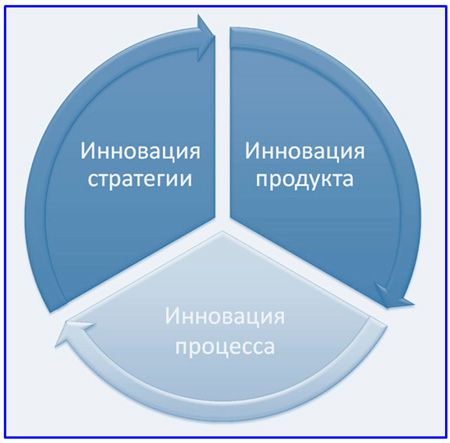
Three types of innovation
Functions of innovation are divided into functions in the economic environment and functions of social significance. The functions of innovation as a result of business activity and government policy are divided into stimulating and reproductive. If a company profits from bringing something uniquely new to the market, it stimulates new innovation. This is the essence of incentive meaning.
Innovations make it possible to reproduce not only itself, but also the entire complex of an enterprise as a system: both operational activity and development. Improving the efficiency of labor and production processes in society as a whole performs a serious social function. Increasing the level of production, quality of products and services through innovation raises the standard of living in society. The intellectual potential of a person as a subject of society develops.
Project activities in the innovation sphere
We can say that a scientific theory, a management system and a system of knowledge in the field of innovations are actively being formed around. The meaning of “innovative” is increasingly being applied to the content of the words “management”, “process”, “program”, “project”. An innovative project (IP) is a basic element of the system of organizing and managing innovations. It is understood as a project (in the traditional interpretation of project management) aimed at solving the unique problem of creating, introducing, mastering innovations, bringing their results to consumers and obtaining benefits.
The presented definition forms a special ideal and universal picture of the results of the project. It is not in vain that innovative projects have been isolated from a certain "substrate", a field of activity for managing innovations. Projects as a means of achieving goals and objectives cannot cover the entire gamut of the management system for creating a new one. Before projects, it is necessary to carry out the most powerful ideological, strategic, educational, structural training. The philosophy of innovation is required to enter the mental and cultural zones of society and organizations.
Innovative projects are linked into a single project system with a complex of interrelationships with each other, with projects of other types in the context of the implementation of a strategic idea. The chain of design events creates a single reproductive model of innovation. In addition, the local tasks of creating and introducing a new one are not able to work out the issue of withdrawing previous generations of an innovative product from the market. And this is also part of the system.
Consumers of the results of innovation are found in a variety of niches and environments. Intra-corporate customers expect unique innovations in their workplaces. Market consumers are among the target audiences of the company's products. Consumers of social services act as parents, students, retirees, etc. State institutions constitute the most significant class of consumers of innovations: the army, health care, science, education.
Innovative projects can be carried out sequentially one after another. Their implementation is also permissible in an independent parallel mode. Moreover, several duplicate projects can be carried out with the same theme. A variation of this form of activity is its imitative, copying nature. This type of work on the creation of something new, when there is an appropriation of other people's intellectual results, also exists. Paradoxical as it may seem, the imitation and compilation of other people's innovations is capable of generating something new, but already its own.
Correlation of innovative projects and process
A company that has chosen an innovation strategy inevitably goes through the formation and development of an innovation process. The organization and execution of this complex process takes place with the inclusion of individual innovative projects. A systematic complex process of selection and selection, generation of new knowledge, implementation and distribution throughout the entire market space - this is an innovation process. It is associated with significant transformations in the material and social environment of society.
The function of creating an innovation, its implementation and distribution is performed by separate economic entities - companies. The form of such activity is innovative projects, which are objects and means of development management. Now let's imagine that in society, in the business environment, ideas are hovering directly, waiting to be realized. As a completely conventional example, we can consider the techno-ideas of self-driving carriages (cars), augmented reality, wearable technologies, etc. In each of these cases, a commercial entity first appears - a company that accepts this idea as an object of innovation.
Suppose an innovator firm embarks on an innovation process, which at the first stages of its development never does without cooperation with applied science, venture capital funds, and without government support. Most likely, it will also require cooperation in the field of research and development and with the owners of technological facilities for mass production of products. A few companies in the world have a full range of opportunities to implement all stages of the innovation process. These include, for example, Samsung.
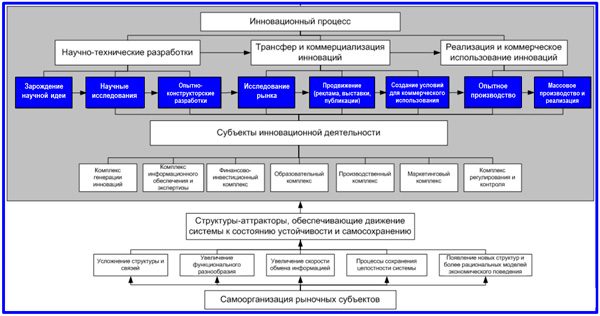
Innovation process model
I would not like to call the innovation process global, but in the modern world this is exactly the case. It is almost impossible to narrow down the entire breadth of events in the process to the size of one firm. Another thing is the development of an innovative project. The concept of the innovation process allows through the project to solve local or complex tasks of the stages under a single governing body. Consider the composition of the main components of the innovation process. It includes interconnected aggregates:
- knowledge, scientific, marketing information;
- scientific research and marketing studies;
- effective means of labor that make it easier to work and make it more productive.
Innovative processes have certain differences from production and other basic and supporting processes of the operating cycle. The following are inherent in innovation creation activities.
- There are significant risks and a state of uncertainty about how to achieve the intended result.
- Detailed planning is not possible, it is impossible to be guided by forecasts.
- There is a permanent resistance not only of persons participating in the innovation process, but also of the very environment of consumption of its results in society or in the market.
- This process itself is dependent on the market and society in which it is produced and developed.
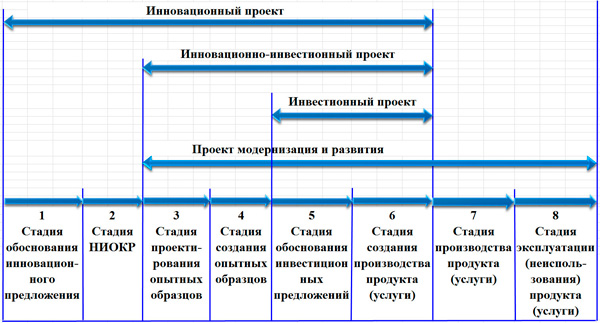
Stages of the innovation process
Content of innovation management
The implementation of the company's innovative activity within it and in the market is based on the system of the management section created in it, called "innovation management" or "innovation management". Management of innovations is based on traditional "whales": organization, analysis of the environment and approaches to problem solving. In addition to the basis, the management system includes a block of opportunities, limitations and security of innovations, sections of resource allocation and gaining experience. The organizational settings of this system include the following aspects.
- Distribution of responsibility for innovation management.
- Search and ranking of innovative ideas.
- Development of the company's innovative policy and bringing it to the participants in the process.
- Formation of an innovative strategy and composition of tasks arising from it.
- High-quality and reliable design (innovative projects).
- Fostering an innovative culture in the company's employees.
- Creation of a special environment that allows for the possibility of learning from mistakes.
- Developing employees to leading innovative positions, expanding their competencies and intentions to contribute to the company's innovation program.
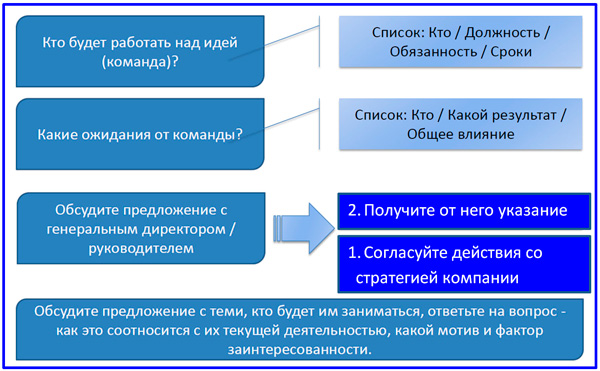
Algorithm for searching for an innovative idea: responsibilities, deadlines, execution
When analyzing the environment in the innovation management system, benchmarking of innovative solutions from competitors and in the company is provided. There is a permanent control of existing trends, trends in the market. Technologies and registered intellectual property on know-how are evaluated. Acceptable technologies are evaluated and ranked for use. Problem solving approaches include the following.
- A holistic approach to products.
- Stimulating the generation of ideas, isolating the significant and minimally competitive ones, their efficient processing.
- Identification of root problems and discrepancies between consumer expectations and market offerings. Formulation of innovative tasks in the value field of consumer preferences.
- Simulation of customer experience throughout the entire product lifecycle of a company as a basis for organizing modeling and design work to find a new one.
- Comprehensive assessment of risks and opportunities according to the degree of innovation and the distribution of work over time.
Methods and means of initiating innovative activity
At the beginning of the article, we have already considered some concepts and categories of innovation as a branch of management science. Among them, we touched on the concept of innovative activity. The innovation process involves a large number of participants both within the company, including the innovator himself, and in the near and far environment. By an innovator, we mean a company employee who is not only the bearer of the idea of innovation, but also personally leads in its implementation.
We have found that the innovation process usually goes far beyond the company that owns the process. This means that when we talk about activity, we should consider the entire chain of parties involved in the process. The initiation of such a large number of people to be active in the creation, implementation and promotion of innovations is a difficult matter. And my open-mindedness is clearly not enough to present to your attention the universal means of such initiation. However, regarding the company, it is quite possible.
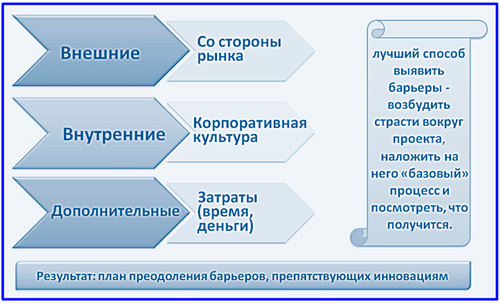
Organizational barriers to initiating innovative activity in a company
The diagram above shows the main barriers to initiating activity. Innovation activity, like projects with a process, must correspond to the company's strategy. It demonstrates the existing relationship between the planned content of the activity and the results. Let's consider the main methods and means of initiation in innovation management.
- Motivating teams, collecting, registering and archiving ideas.
- Retrospective review, analysis of information and decisions.
- Sessions of group search for ideas and their ranking by methods of teamwork.
- Ensuring the implementation of models for consumers to gain experience in using the innovation product.
- Performing ethnodemographic research.
- Multidimensional design (including the actual innovative project).
- Resolving issues with intellectual property.
- Allocation, formation and development of knowledge management and talent management.
- Figurative prototyping of the expected results.
- Assessment of all possible risks of project implementation.
Variety of types of innovative projects
The classification of innovative projects as a systemic phenomenon, first of all, is made from the point of view of the inclusion of the main element of innovation - the depth of its substantiation. In modern times, the highest measure of this is the scientific method and approach. Consequently, all IP can be divided into two dichotomous parts: using scientific and technical research, development and not using them.
Thus, scientific and technical innovations are distinguished, subdivided into product and process types of innovative projects. This division is made in the same way that innovation itself is divided by focus into unique product, process and strategy changes. Product and process innovations are interconnected, since product innovations cause procedural innovations and vice versa. The model for dividing projects according to this criterion is shown in the diagram.
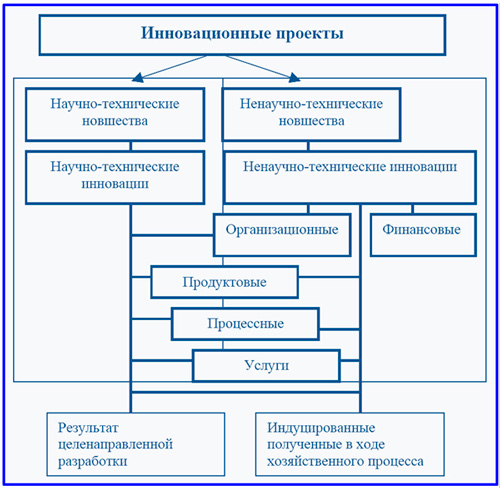
Scheme for the classification of project innovations by the nature of innovations
If an innovation is based on scientific and technical development, it presupposes the implementation of a project for its implementation. Among the first stages, an innovative project includes a research and development stage. The next classification of projects is their division based on the degree of coverage of the stages of the innovation process. A complete project for the development and implementation of innovations, an incomplete project of the first kind and an incomplete project of the second kind of innovative content are distinguished.
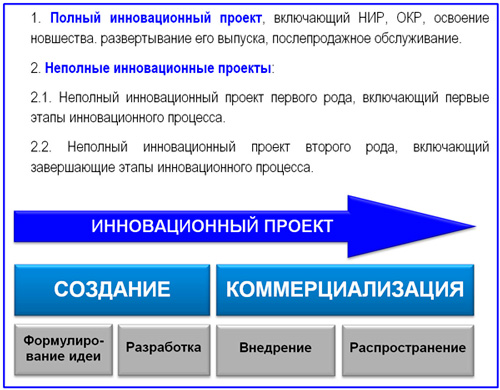
Two-phase model of a complete innovation project
The types of innovative projects are also divided according to the level of scientific and technical significance and the scale of the tasks to be solved. According to the first of the named classification signs, projects are divided into 4 types.
- Modernization projects. The prototype of the product, its design features, production technology do not fundamentally change.
- Innovative projects. Substantial improvements are made to the product design.
- Advance projects. Advanced technical solutions are used that fundamentally distinguish the new product from the old one.
- Pioneering projects. Completely new materials, design solutions are being developed, and unique technologies are emerging.
Taking into account the scale of the projects being implemented, innovative design tasks are divided into 3 groups.
- Monoprojects. The only innovative idea is embodied and promoted to the market within the framework of the actions of one company.
- Multiprojects. A whole pool of monoprojects is regulated from the focal point. Multiprojects solve multifaceted technological problems (creation of a unique medical center for surgery, construction of a collider, etc.).
- Megaprojects. Multipurpose and cross-sectoral programs with centralized government funding. For them, special control centers are created under the control of ministries and departments (the level of creating a breakthrough technology in the industry, projects for re-equipping industries, etc.).
Life cycle of innovative projects
The life cycle of an innovative project, like any other project task, obeys certain patterns. It sequentially includes the main elements of an innovative project and two key time points: the moments of launch and closure. The internal stages of creating innovations in their composition depend on the type, internal content and scale of the project. Milestones as control points for making fateful decisions have a special specificity.
Due to the fact that the development of an innovative project has higher risks of unsuccessful completion and loss of funds, at the moments of the onset of milestones, it is necessary to carefully analyze the results achieved. Of particular importance is the level of the person who makes decisions about the next stages of the project and the feasibility of its continuation. Design events should be treated like a minefield: I took a step - I stopped and looked around, the chances are still high - we move on.
Therefore, for an innovative project, a system of step-by-step verification of intermediate results and solutions is actively used. The advantage of this system is manifested in the development of a design work plan of such a depth level that the tasks set allow for continuous and step-by-step control. All stages of the project according to the GOST R 55347-2012 Standard provide for a procedure for confirming the satisfactory results of their results.
Confirmation is accompanied by intermediate checks that cover the revision of work at one or all of the previous stages. They must confirm that the level of the organization, the functional environment is unchanged, consistent with the company's strategy, project objectives and customer expectations. One of the conclusions of the intermediate checks may be recommendations for reorientation or closure of the project in the presence of deviations from the original goals or their unreasonable fragmentation. Decision verification stages and event variants include:
- coordination of activities for the stage, new approval of the project plan for the transition to the next stage;
- permission to move to the next stage;
- requirements for making changes and additions to the content of the stage;
- requirements for re-verification, if necessary;
- return of designers to previous stages for revision and redesign;
- refusal to accept the results of the work performed by the stage and the requirement to re-perform them;
- suspension of the progress of work on the project, conservation of results for a specified period or prematurely;
- stopping and exiting the project.
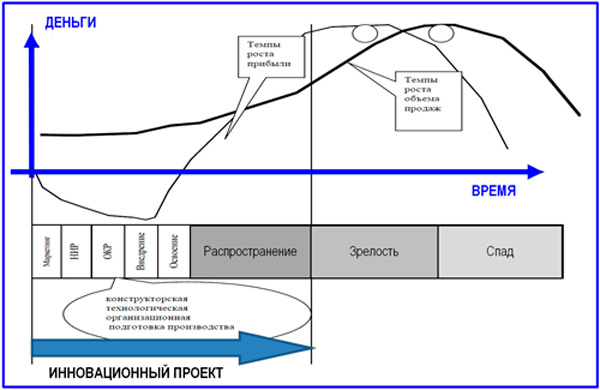
Life cycle stages and secondary structure of a product innovation project
Features of the design phase in IP
Another model of the IP life cycle will be presented in this section. In this model, the stages of commercial promotion, distribution of the project product, which take up a large amount of work, are practically not expressed. That is, the life cycle shown in the diagram gravitates towards innovations of the second kind without taking into account the presence of a scientific and technical aspect. The development of an innovative project is specific due to the special role of two states that do not belong to the design phase. This refers to the phases of activity before design and implementation and phases after it.
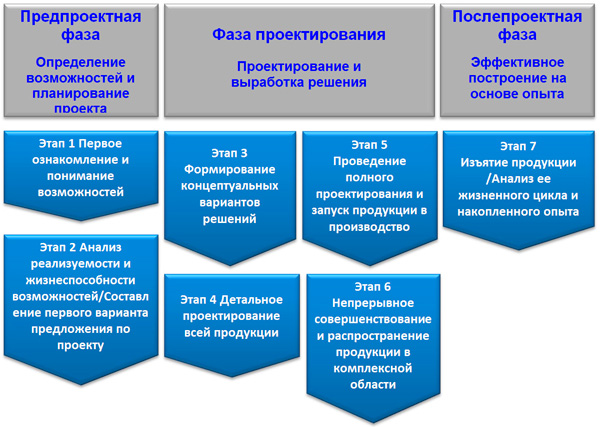
The most important stages in the design of innovations according to the Standard GOST R 55347-2012
Before considering the design stages, let's reconstruct the general sequence of events. The company has adopted an innovative development strategy. Innovation management is being actively implemented. From among the top management, a person responsible for innovation and development of activities in the form of an individual entrepreneur was appointed. He is also the curator of the relevant projects. A structure has been formed within the company dealing with this topic. An innovative process has been launched. Ideas are selected, ranked and ready to be transferred to the pre-project phase. This is the infrastructure and the forerunner for the design of innovation.
As a rule, the newly created council for innovation policy (sometimes a scientific and technical council), with almost its entire composition, forms IP management teams. The first task of the project management team is to identify the opportunities themselves to complete the project. Then the first iteration of the project plan is carried out in enlarged form. The output of this phase is the approval by the decision maker of the presentation of the project with a conclusion about its start.
The diagram above illustrates the stages of innovation design, pilot production, and the transition to mass production and product distribution. Several stages are performed at the same time. The peculiarities of individual IPs also allow the presence of additional and intermediate stages within the phase. The design and implementation stages are subject to detailing and configuring for optimal planning purposes. The initial composition of information about the stages includes:
- general information about the stage (name, purpose);
- tasks solved at the stage;
- a list of unsuccessful activities to be carried out;
- the composition of persons responsible for the events and tasks of the stage;
- terms of tasks and tasks;
- mechanisms and resources involved in the stage;
- techniques, methods and other tools for innovative solutions at the stage;
- results of tasks and the whole stage;
- indicators for staged checks.
The composition of the participants in the innovation project
When we talk about the system of innovation management, it is advisable to separate the participants in the innovation process and the participants in the IP. The composition of the participants in these two categories overlaps in many ways, but since the process is much broader than the project, there are differences. First of all, let's consider who are the stakeholders both in the process and in the increase in the number of projects in the innovation sphere:
- the state represented by numerous institutions and regions;
- municipal authorities;
- fundamental science;
- subjects of scientific research and applied development;
- venture and investment funds;
- companies-developers of innovative solutions and their owners;
- companies manufacturing components and the product itself;
- end consumers of the product.
The participants in the innovation process are divided into persons who create the demand for innovations, into subjects offering innovative solutions, and into intermediary participants. The first category includes government agencies and institutions (army, medicine, education, etc.), companies that use innovative products for production, and end consumers. A group of participants actively forming (actually or expected from them) a proposal on the market for innovative products:
- holdings and enterprises of the military-industrial complex;
- Research institutes and universities;
- engineering companies;
- manufacturers of high-tech goods and services.
The group of innovative intermediaries includes:
- investment capital market;
- business incubators;
- technoparks;
- free economic zones as business entities and tax benefits;
- innovation and technology centers;
- patent and licensing authorities;
- commercial banks;
- insurance and leasing companies.
Everything that was noted above predetermines the composition of participants and stakeholders in an innovative project. Participants of an innovative project build all interaction through the developer. Below is the corresponding diagram, in which a collective participant is considered as a developer, consisting of a curator, a project manager, a project management group and a team. Among the inner circle, one can single out the customer, investor, designer and contractor (if the contractor is a separate company, SIC).
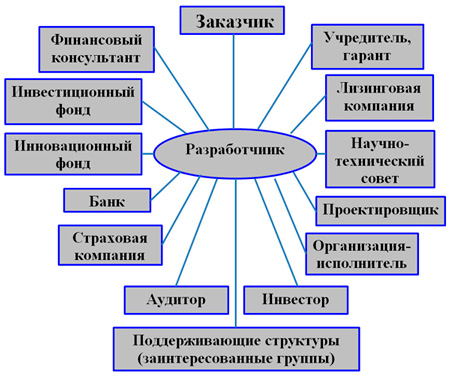
Main stakeholders and IP participants
Selection methods for innovative projects
Due to the high risks of developing and implementing IP, the financial justification for choosing a project among numerous innovative intentions is of great importance. This procedure is also significant because, in addition to the risks of this category of project tasks, large potentials in terms of revenues and profits in case of success are inherent. The blue ocean strategy theory demonstrates in detail such possibilities thanks to an innovative approach not only in the material embodiment of a new idea, but also along the entire value chain for the consumer.
The banking sector is one of the important innovative intermediaries. Some commercial banks are beginning to specialize in long-term lending for projects for investment in innovation. They independently master the methods of selecting innovative projects. Credit institutions are more and more actively conducting independent evaluations of intellectual products, which in itself can give impetus not only in solving the problems of lending to innovators. Bank appraisal is a tool for external expertise in the selection of projects. The innovative project receives a financial justification, which undergoes qualified verification and testing.
Some banks, as part of their credit departments, have teams of professional experts who are able to carry out a qualified assessment of a portfolio of innovative projects. At the first stage, the analysis and issuance of a preliminary conclusion on internal innovative characteristics (return on investment, project implementation period, etc.) is carried out. The rationale for attracting external sources is analyzed according to the banking methodology, the conclusions are included in the conclusion. The basic estimated indicator is the price of capital plus the surplus profit margin. The limits of capital for self-financing of innovations and the possibilities of attracting it are determined.
The selection methods used by banks for innovation projects include active assessment tools. Among them is the method of valuation of intangible assets, namely the audit of registered intellectual property rights. The expert analysis is aimed at checking the validity of the declared value of the intellectual value object, establishing the size of the possible return from the position of market valuation. Experts also perform additional analysis of the security of intellectual resources, since this issue is a risk factor for the project.
Then the expert group proceeds to the main analytical block. The presented justification in the form of a business plan for the project, calculations of the effectiveness of internal and external investments, analysis of sensitivity and the composition of all kinds of risks are subject to verification and assessment. A model of measures for the selection of projects for long-term lending, and, consequently, for their possible launch using borrowed funds, is presented below.
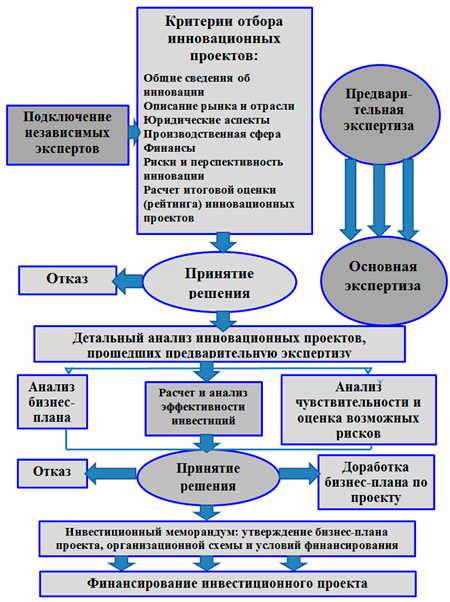
Model of evaluation procedures for the selection of innovative projects
The theory of Kondratyev's cycles and world news clearly indicate that the sixth technological order will begin its march in the coming years. They talk about it in Russia, but the innovation process is still not gaining momentum. Oddly enough, the Russian economy still has a chance to become innovative. I am convinced that this is inevitable. Therefore, a practicing PM should definitely spend time mastering the innovative specifics, studying the basics of developing and implementing an IP, the stages of its life cycle, and methods for their selection. Imagine that tomorrow the regulatory framework will change, a unique Russian mechanism of mass innovation will appear, and you are ready - a great option, right?
 Discounted payback period
Discounted payback period Methodological aspects of project management
Methodological aspects of project management Scrum development methodology
Scrum development methodology